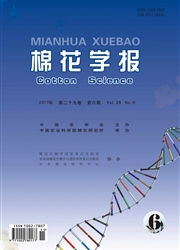

 中文摘要:
中文摘要:
棉纤维的正常发育需要大量的蔗糖供应。果糖-1,6-二磷酸酶(FBP)是植物蔗糖合成途径中的关键酶.研究FBP将有助于揭示复杂的棉纤维发育分子机理,为纤维品质改良提供优异的基因资源。本研究以一个在陆地棉蛔纤维不成熟突变体和遗传标准系TM-1纤维发育中显著差异表达的EST序列(GenBankNo.ES795598)N探针,通过电子克隆方法,结合cDNA及基因组全长基因PCR扩增、测序验证,获得一个棉花细胞质果糖-1,6-二磷酸酶Gb只妒基因(GenBankNo.KF305323)。该基因ORF全长1026bp,编码341个氨基酸,含有12个外显子,11个内含子。Gh既妒在二倍体棉种中含1个拷贝,在四倍体棉种中含2个拷贝,A、D两个亚组中各一个。利用SNP标记将G自FBP在异源四倍体中的一个拷贝定位于D2(Chr.14)染色体上。Q-PCR分析表明,该基因在纤维组织中优势表达.在其他组织中表达较低。GhFBP在开花后19d的纤维组织中表达水平迅速增高。在次生壁发育早期的19、22DPA纤维组织中,该基因在TM-1中的转录本显著高于iIn纤维不成熟突变体材料,推测Gh船P对纤维次生壁发育早期的纤维品质形成有重要作用。
 英文摘要:
英文摘要:
Cotton fiber development depends on a large supply of sugar. Fructose-1,6-bisphosphatase (FBP) plays a central role in sucrose metabolism. Structural and fianctional analysis of the FBP gene will contribute to revealing the complex molecular mech- anism of fiber development, and could also provide elite gene resources for the improvement of cotton fiber quality. A novel gene encoding cytosolic FBP, designated as GhFBP (GenBank No. KF305323) was obtained by in silico cloning, based on an expressed sequence tag (GenBank No. ES795598) that was differentially expressed between G. hirsutum acc. TM-1 and G. hir- sutum acc. im, an immature fiber mutant, combined with reconfirmation of open reading frame information at the transcriptional and genomic level. GhFBP contained an open reading frame of 1,026 bp that encoded a polypeptide of 341 amino acids. The genome sequence indicated that GbFBPP has 12 exons and 11 introns. There is one copy of GhFBP in diploid cotton species G. herbaceum and G. raimondii and two copies in tetraploid cotton species G. hirsutum acc. TM-1 and G. barbadense cv. Hai 7124, with one each in the A- and D-subgenome. One of the GhFBPhomologs in the tetraploid was located to chromosome D2 (Chr.14) using a developed single nucleotide polymorphism marker. Quantitative PCR expression analysis showed that GhFBP was pre- dominantly expressed in developing fibers, and was expressed at low levels in other tissues, including the root, stem, leaf, petal, and anther. The expression level of GhFBP increased rapidly after 19 days post anthesis in fiber tissue. GhFBP showed a signifi- cant difference between TM-1 and the im mutant at 19 and 22 days post anthesis, which is the early stage of fiber secondary cell wall development, suggesting that GhFBP plays a key role in the early stage of fiber secondary cell wall development.
 同期刊论文项目
同期刊论文项目
 同项目期刊论文
同项目期刊论文
 EST-SSR Sequences Revealed the Relationship of D Genome in Diploid and Tetraploid Species in Gossypi
EST-SSR Sequences Revealed the Relationship of D Genome in Diploid and Tetraploid Species in Gossypi The GhPEL gene, encoding a pectate lyase, plays an essential role in cell wall loosening by depolyme
The GhPEL gene, encoding a pectate lyase, plays an essential role in cell wall loosening by depolyme Molecular cloning and localization of a novel cotton annexin gene expressed preferentially during fi
Molecular cloning and localization of a novel cotton annexin gene expressed preferentially during fi Effect of H2O2 on Fiber Initiation Using Fiber Retardation Initiation Mutants in Cotton (Gossypium h
Effect of H2O2 on Fiber Initiation Using Fiber Retardation Initiation Mutants in Cotton (Gossypium h 期刊信息
期刊信息
